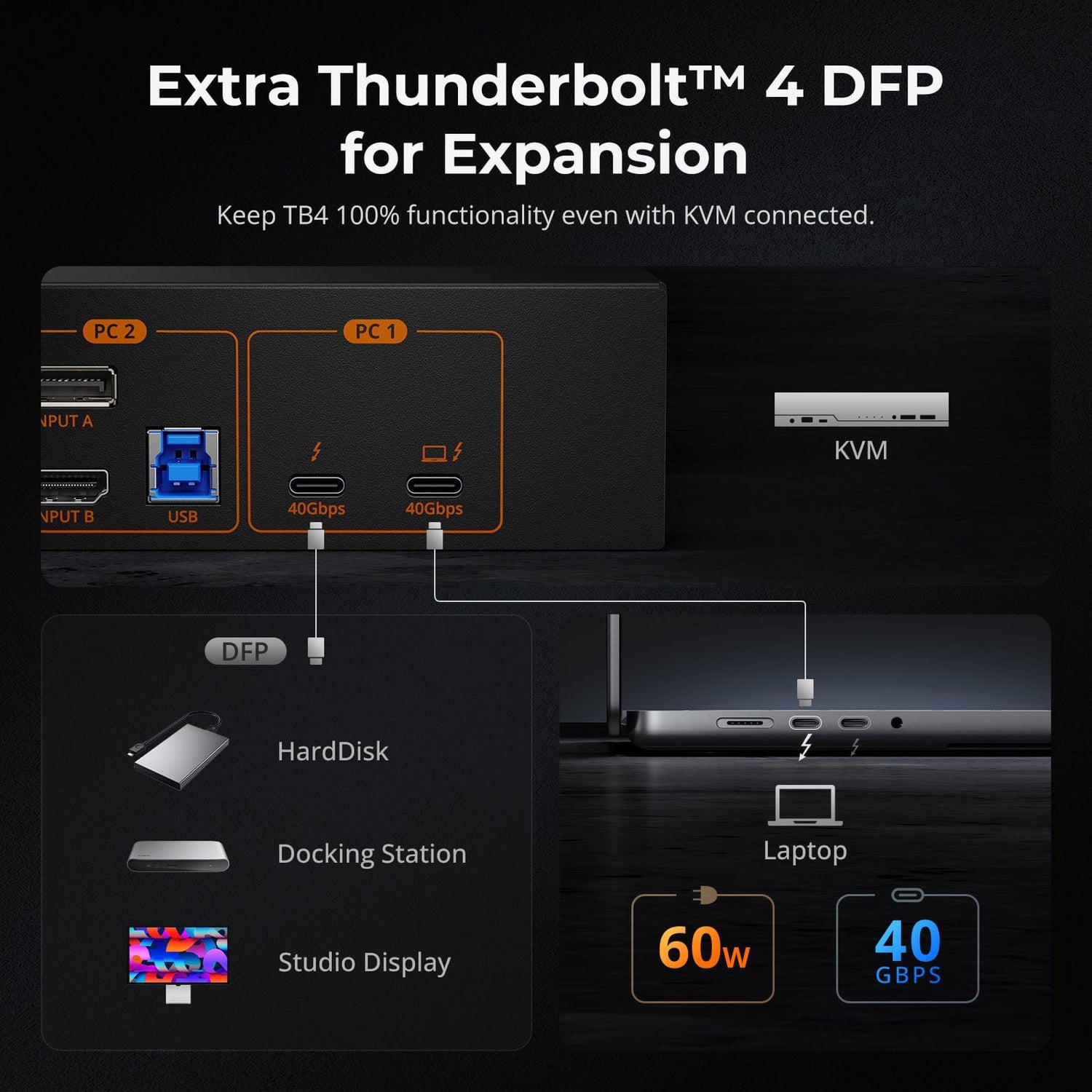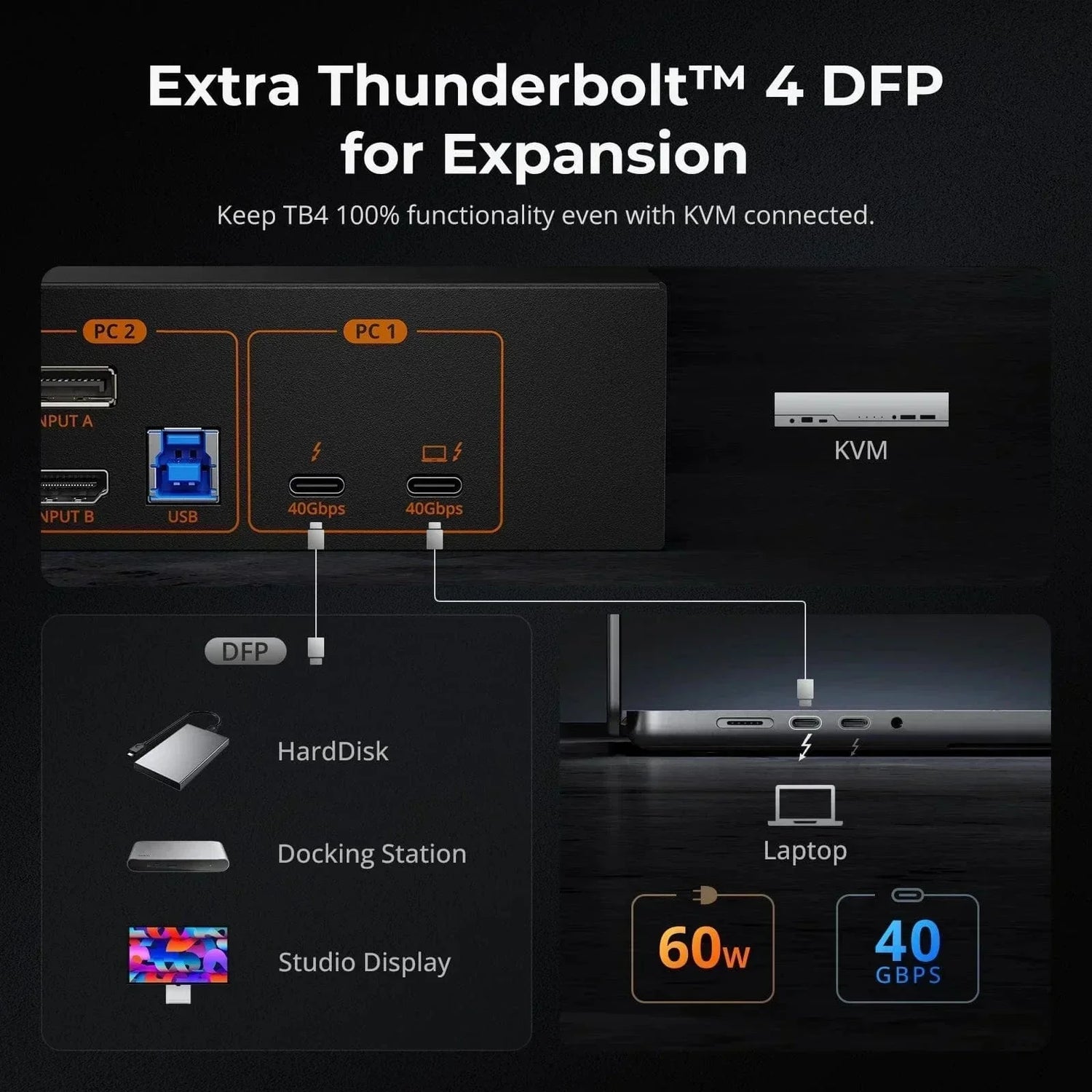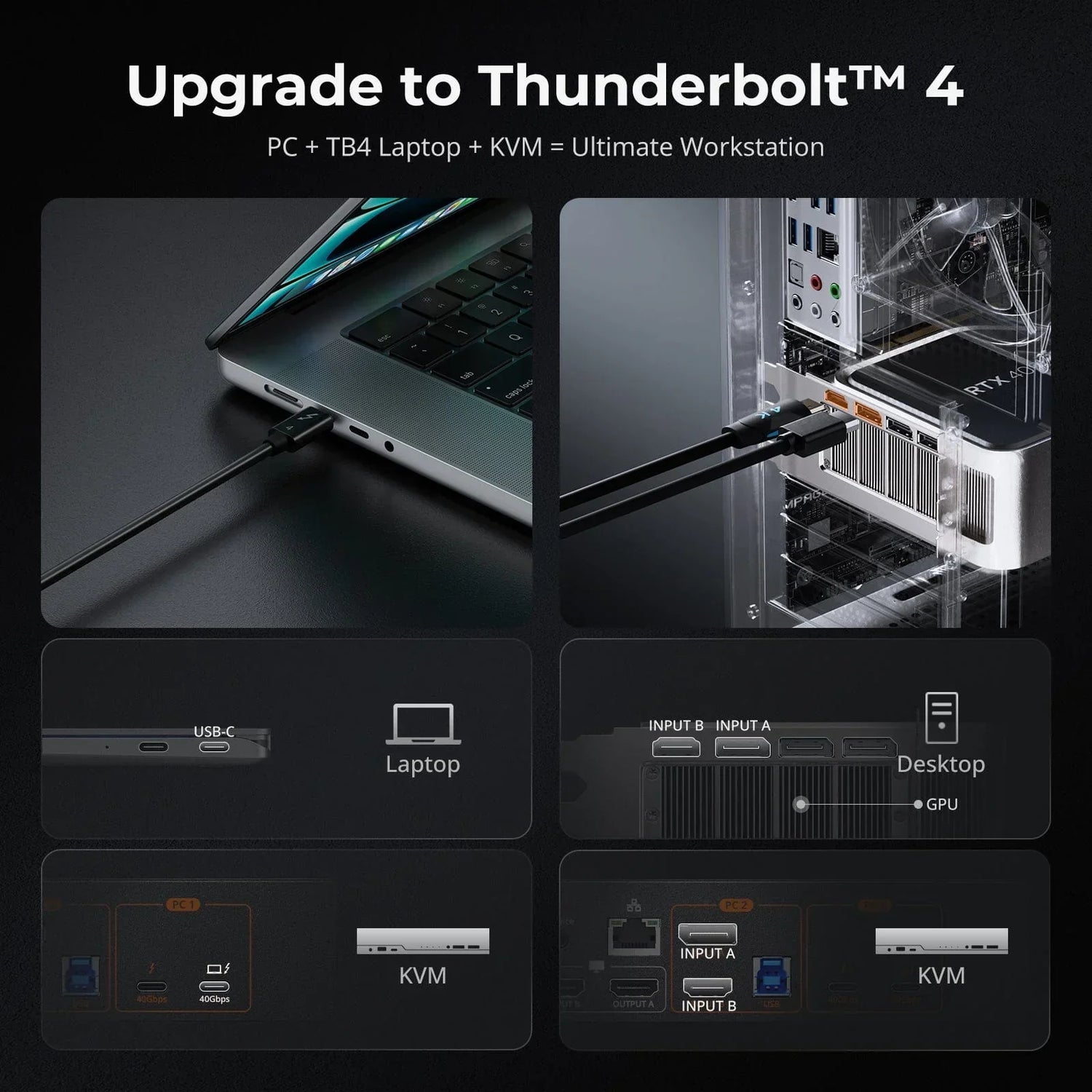What is A KVM Switch?
A KVM (keyboard, video, mouse) switch is a hardware device that allows users to control multiple computers or servers in one or between several monitors using a single set of keyboard and mouse. It can also be referred to as a "CAT x KVM switch" due to its utilization of copper cables such as Cat5e or Cat6 for interconnecting various devices.
By connecting the computers and the monitor(s) to the KVM switch, users can seamlessly switch control between them, typically through the press of a button or keyboard shortcut. This intuitive functionality grants effortless computer switching capabilities, conserves space, and eliminates the need for redundant components. Instead of requiring separate keyboards and mice for each system, a single KVM switch suffices, enabling swift transitions between different devices.
What is A KVM Switch Used for?
When one’s job responsibilities involve the use of multiple computers, they always use more than one set of peripherals, resulting in a cluttered and disorganized desktop environment. So, just imagine the remarkable convenience offered by a single device that enables seamless switching and control of multiple computers using just one set of peripherals (keyboard and mouse).
KVM switches are commonly used in environments where space is limited or where users need to manage multiple systems efficiently, such as data centers, server rooms, or desktop setups with multiple computers. They help streamline operations, reduce clutter, and improve productivity by eliminating the need for separate peripherals for each computer.
Whether you have dual monitors, multiple PCs, laptops, or even more devices, a KVM switch is your solution for streamlining operations, eliminating cable clutter, and reducing space usage, all while using just one set of keyboard and mouse.
How does A KVM Switch Work?
Exactly how it works is complicated to explain, but in simple terms, it simulates the computer's peripherals and constantly maintains a "fake" signal. When switching, the KVM switch replaces the analog signal with the signal from the actual peripheral, providing a smooth and unobtrusive conversion.
Typically, a computer's operating system automatically attempts to detect incoming keyboard, mouse, and monitor signals upon first boot. Only after these connections are confirmed does the monitor display the startup page. The KVM switch, on the other hand, allows the user to switch with the correct signal each time through signal emulation, thus ensuring that there is no harmful effect on the CPU operation of the computer.
A KVM switch works by providing a central hub for connecting multiple devices. In general, a device can be connected to a KVM switch using a Cat5 cable or a dedicated KVM cable kit. To switch between devices, connect all target input sources to the KVM switch, which is connected to the keyboard, monitor(s), and mouse in turn. We can also think of a KVM switch as a signal controller that guides input and output signals between these network devices via a keyboard, monitor(s), and mouse, easily switching between devices without physically disconnecting and reconnecting cables.
In the past, hot-plug technology didn't exist, so every time you wanted to replace a keyboard or mouse, you had to restart your computer so that the CPU could detect any peripherals. While this is no longer the case, KVM switchers still do similar things, as they trick the CPU into thinking there is a connection so that when you finally switch, it goes smoothly.

All types of KVM Switches
There are many ways to classify KVM switches. A fair way to classify is the signal type. The video signals between different interface types are completely different. Not only does the difference lie in appearance, but each signal type also has its own separate built-in transmission protocol, bandwidth, and transmission speed.
HDMI KVM Switch
An HDMI KVM switch is a type of KVM switch specifically designed to support HDMI (High-Definition Multimedia Interface) connections for video and audio output. It enables users to control multiple computers or devices using a single (or multiple) HDMI monitor(s), keyboard, and mouse setup.
It provides HDMI signal switching without affecting video quality. These switches offer fast switching times with no latency. They are ideal for applications such as broadcasting, high-end medical imaging, interactive digital signage, home theater and even industrial automation. HDMI KVM switch is the most common and most popular option for users.
Check out more details about our HDMI KVM switch: TESmart HKS0401A3U - for 4 pcs & 1 monitor, USB3.0, 4K@60Hz




VGA KVM Switch
A VGA KVM switch is a type of KVM switch that specifically supports VGA (Video Graphics Array) connections for video output. It allows users to control multiple computers or servers using a single (or multiple) VGA monitor(s), keyboard, and mouse setup. These switches support dual, triple, quad, or even more VGA video connectors, giving you easy access to video heads on each channel.
DP (DisplayPort) KVM Switch
A DP (DisplayPort) KVM switch is a type of KVM switch specifically designed to support DisplayPort connections for video and audio output. It enables users to control multiple computers or devices using a single (or multiple) DisplayPort monitor(s), keyboard, and mouse setup.
Compared with the HDMI interface, the DP interface has a higher bandwidth, lower design difficulty, and supports the transmission of audio as the HDMI port. Although the popularity rate is not as large as the HDMI interface, it is widely used in e-sports, high-quality image and video design, and editing fields.
Check out more details about our DP KVM switch: TESMart DKS402-E23 - for 4 pcs & dual monitors, USB3.0, 4K@60Hz




DVI KVM Switch
A DVI KVM switch is a type of KVM switch specifically designed to support DVI (Digital Visual Interface) connections for video output. It allows users to control multiple computers or devices using a single (or multiple) DVI monitor(s), keyboard, and mouse setup. Like the VGA interface, the DVI does not support audio transmission. These types of switches can support single or dual-link DVI-D or DVI-I and can even be backward compatible with analog VGA signals using passive or active video converters.
These switches are ideal for critical enterprise-class applications that require reliable digital image quality and fast switching of redundant hardware, such as in broadcast play centers, process monitoring and control, staging LABS, and data centers.
USB KVM Switch
A USB KVM switch is a type of KVM switch specifically designed to support USB connections for keyboards, mice, and sometimes other USB peripherals. It enables users to control multiple computers or devices using a single set of USB peripherals, such as a keyboard, mouse, and potentially other USB devices.
USB KVM switches basically use USB Type-C as an interface (arguably all of them), and due to Type-C's excellent transfer protocol, USB Type-C KVM switches are generally smaller and do not require an additional audio interface. On certain devices, it is even possible to use a single input wire to achieve multiple display video outputs.
Check out more details about our: TESmart USB-type C KVM Switch CKS202-P23, 4K@60Hz, MST, EDID for 2 Laptops




Mixed KVM Switch
A mixed KVM switch is a type of KVM switch that supports connections for different types of video outputs, such as VGA, DVI, HDMI, DisplayPort, and various other interfaces, while also accommodating USB connections for keyboard, mouse, and other peripherals.
As the name suggests, a single KVM can have more than one type of video interface at the same time. In fact, this kind of hybrid-interface KVM is very common. It has the advantage of integrating various video signals and being compatible with more devices.
Check out more details about our: TESmart Mixed KVM Switch HCK402-P23, 4K@60Hz, MST, EDID for 2 Laptops & 2 PCs




The Benefits of Using A KVM Switch
Space Savings In today's multi-device environments, having multiple monitors, keyboards, and mice can clutter your workspace. A KVM switch allows you to consolidate these peripherals and control multiple computers or devices using just one set to reduce clutter, saving valuable desk space.
Cost-Effective Solution Instead of purchasing separate peripherals for each computer or device, a KVM switch lets you share one set of peripherals among multiple PCs and monitors. This not only saves you money on additional hardware but also reduces maintenance costs.
Efficient Multitasking With a KVM switch, you can efficiently multitask by switching between different computers or devices with ease. Whether you're working on multiple projects or managing various systems, a KVM switch simplifies the process, eliminating the need for additional peripherals.
Flexibility in Connectivity KVM switches support various types of video interfaces (such as VGA, DVI, HDMI, and DisplayPort) and USB connections, providing flexibility to connect different types of computers or devices. This versatility ensures compatibility with a wide range of hardware configurations.
What are the Most Suitable Usage Scenarios?
Home Offices Individuals with multiple computers or laptops for work-related tasks. For instance, professionals such as stockbrokers, music producers, and IT specialists may require KVM switches or docking stations for tasks ranging from monitoring stock statistics to recording music, to managing multi-platform coding.
Check out more details about our TESmart KVM HKS202-E23 for best gaming experience - Supports 4K 60Hz, one-button switch, USB 3.0




Workspace Tool All office desk are perfect and suitable for KVM switches, especially for IT programmers, Internet/computer engineers, or art designers. Unlike working from home, people in the office are more likely to use two or more screens. These professionals rely on KVM switches for diverse activities such as creating marketing materials, designing graphics, and managing employee data efficiently.
Networking Control Center In most control rooms, for example, in a railroad deployment room, each employee has to view multiple computers and has multiple operating systems to operate. A KVM switch is not only pretty handy for personal use, but also works well for a large system. Employees can switch the screen content at any time, and managers can also have unified screen display control.
Data Center Due to the large number of devices or servers that need to be controlled, KVM switches are frequently used in data center applications. In addition to LAN administration, labs, manufacturing operations, multiple computer desktops, etc., KVM switches are frequently utilized.
What is A Dual or Multiple Monitor KVM Switch?
KVM can work on more than one monitor. But this requires a specific model, such as the TESmart HKS0403A1U, which allows four computers to be linked to three monitors. You'll need three HDMI cables per computer, and when properly connected, you can control the display through a remote control, hotkey, or KVM front panel. HKS0403A1U supports three screens, mixed screen mode, users can customize the control according to their own preferences. The same is true for multiple screens, but it is worth noting that under normal circumstances, each host needs to be connected to the same number of lines as the output source, such as if you want to display content on three screens, the host should be connected to three data lines to the input port every day.
Check out more information about TESmart Triple Monitor KVM HKS403-P23 - supports 4PCs & 3monitors, USB 3.0, and 4K@60Hz




What are the Switch Methods?
For different brands and different models, the switching method is different. The following is a description of the common switching methods.
-
Remote Control Switching It is usually the most convenient and fast way to switch. You only need to press a specific button on the remote controller to quickly switch signals. The remote controller allows users to remotely control the KVM, getting rid of the distance limit, and at the same time, allows the administrator to quickly control multiple screens and multiple signal sources in a large scenario.
-
Front Panel Button Switching Method Many KVM switches have buttons that allow you to switch between PC signal sources with a single press. In a multi-screen KVM, there are usually several buttons on the front panel to allow users to switch between a single screen and control all screens in a unified manner.
-
Hotkeys Switching Basically, every brand has its own hot-key toggle combination. For TESmart, it is easy to switch by simply pressing the button shown below. And the hot key, in addition to controlling the switch signal source, also has more practical uses. For details, please see our product manuals.
-
Mouse Wheel Switching This is also a special switch method only adapted for specific TESmart models, normally for the newest product. Mouse wheel switching method can quickly switch input sources by mouse operation, double-click the mouse wheel to switch to the next input port. Mouse wheel switching mode is off by default. You can use keyboard hotkey command [Right-Ctrl] + [Right-Ctrl] + [F6] to turn on mouse wheel switching mode.
-
RS232 Control Switching RS232 control of KVM switches refers to the capability of controlling the KVM switch through a serial communication protocol known as RS232. RS232 is a standard protocol used for serial communication between devices, often via a serial port on a computer or other equipment. Users can send commands to the KVM switch through the RS232 interface using a computer, terminal, or other RS232-compatible device. These commands can include instructions for switching between connected computers or devices, adjusting settings, or performing other functions supported by the KVM switch.
Conclusion
KVM switches offer a versatile and efficient solution for managing multiple computers or devices from a single workstation. By consolidating control over multiple systems, KVM switches help save space, reduce clutter, and enhance productivity. Whether through traditional physical switching, remote control options like IR, LAN, or RS232, or software-based management, KVM switches provide users with flexibility, convenience, and centralized control. These benefits make KVM switches invaluable tools in a wide range of environments, from home offices and small businesses to large enterprises and data centers, where efficient device management and resource optimization are paramount.




